To What Extent Does UK Inward Investment Affected by Brexit?
VerifiedAdded on 2023/04/11
|18
|4076
|169
Project
AI Summary
This research proposal investigates the extent to which the UK's inward investment will be affected in response to Brexit. It begins with an introduction and background, emphasizing the importance of inward investment (primarily Foreign Direct Investment, or FDI) for economic growth, employment, and GDP, and highlights the potential impacts of Brexit. The rationale of the study underscores the significance of understanding Brexit's effects on FDI, examining how political, economic, and legal factors influence investment. The proposal outlines the research aim and objectives, including understanding inward investment concepts, assessing factors, and evaluating Brexit's influence, leading to specific research questions. A comprehensive literature review explores the concept of UK inward investment, factors influencing it, and the potential impacts of Brexit, drawing on existing studies. The methodology section details the qualitative research strategy, the use of primary and secondary research, data sources, and data collection methods. The proposal also includes a timescale, conclusion, references, and appendices, including figures and tables. The study aims to provide valuable insights into the relationship between Brexit and UK inward investment, offering recommendations to stimulate investment in the post-Brexit era. The research will collect data from managers of Walmart using a purposive sampling technique.
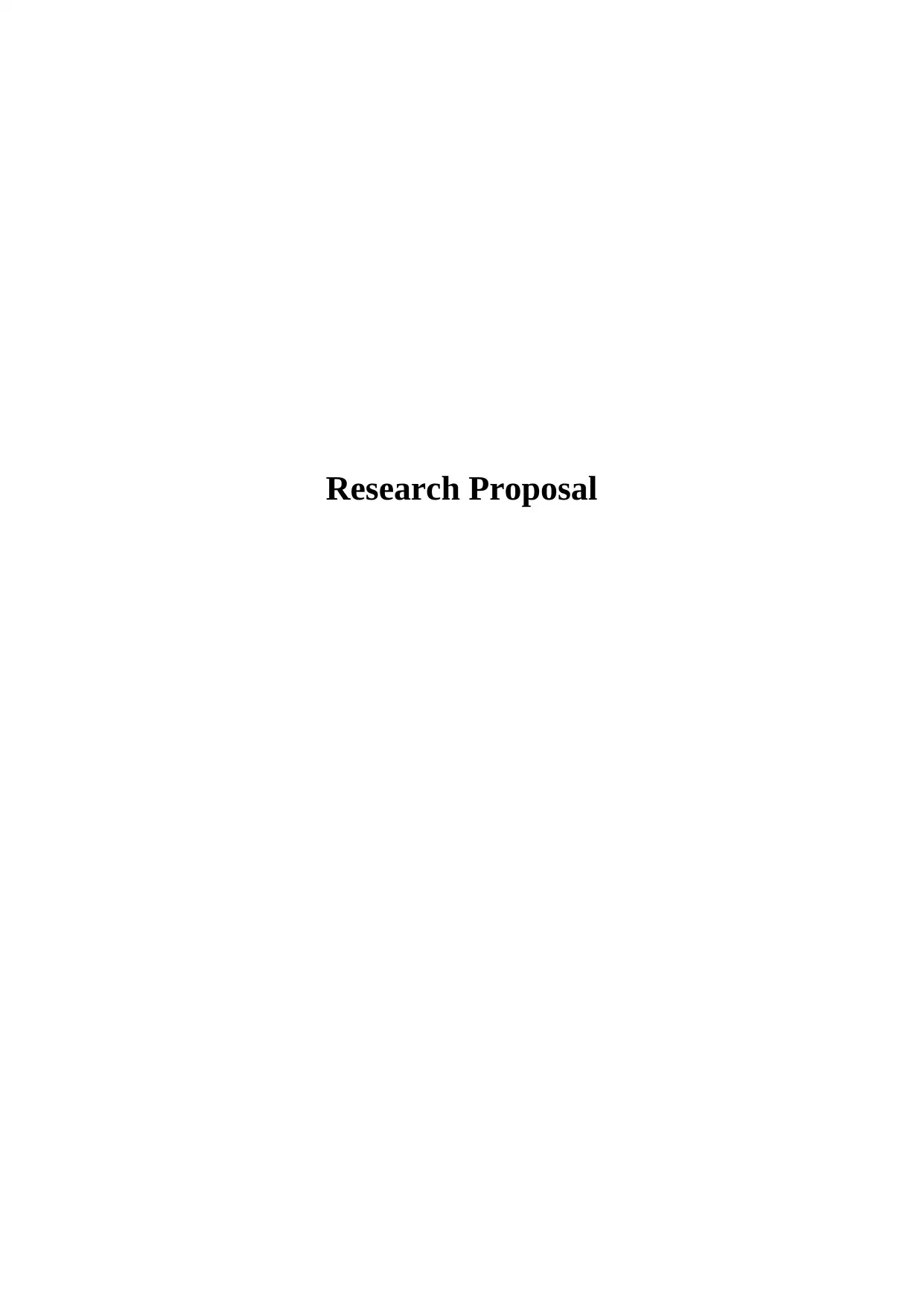
Research Proposal
Paraphrase This Document
Need a fresh take? Get an instant paraphrase of this document with our AI Paraphraser
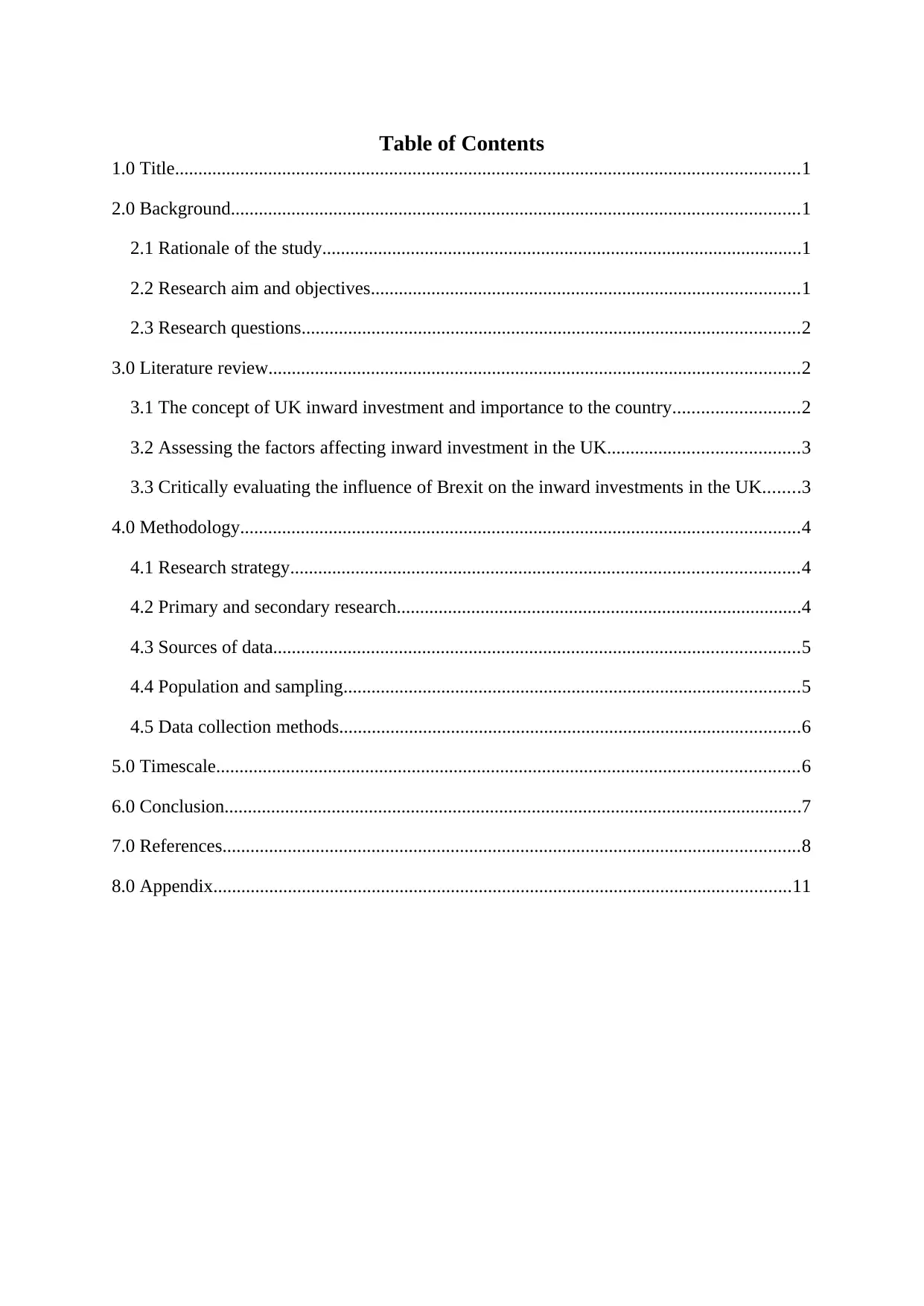
Table of Contents
1.0 Title......................................................................................................................................1
2.0 Background..........................................................................................................................1
2.1 Rationale of the study.......................................................................................................1
2.2 Research aim and objectives............................................................................................1
2.3 Research questions...........................................................................................................2
3.0 Literature review..................................................................................................................2
3.1 The concept of UK inward investment and importance to the country...........................2
3.2 Assessing the factors affecting inward investment in the UK.........................................3
3.3 Critically evaluating the influence of Brexit on the inward investments in the UK........3
4.0 Methodology........................................................................................................................4
4.1 Research strategy.............................................................................................................4
4.2 Primary and secondary research.......................................................................................4
4.3 Sources of data.................................................................................................................5
4.4 Population and sampling..................................................................................................5
4.5 Data collection methods...................................................................................................6
5.0 Timescale.............................................................................................................................6
6.0 Conclusion............................................................................................................................7
7.0 References............................................................................................................................8
8.0 Appendix............................................................................................................................11
1.0 Title......................................................................................................................................1
2.0 Background..........................................................................................................................1
2.1 Rationale of the study.......................................................................................................1
2.2 Research aim and objectives............................................................................................1
2.3 Research questions...........................................................................................................2
3.0 Literature review..................................................................................................................2
3.1 The concept of UK inward investment and importance to the country...........................2
3.2 Assessing the factors affecting inward investment in the UK.........................................3
3.3 Critically evaluating the influence of Brexit on the inward investments in the UK........3
4.0 Methodology........................................................................................................................4
4.1 Research strategy.............................................................................................................4
4.2 Primary and secondary research.......................................................................................4
4.3 Sources of data.................................................................................................................5
4.4 Population and sampling..................................................................................................5
4.5 Data collection methods...................................................................................................6
5.0 Timescale.............................................................................................................................6
6.0 Conclusion............................................................................................................................7
7.0 References............................................................................................................................8
8.0 Appendix............................................................................................................................11

List of figures
Figure 1: Ratio of new jobs from FDI......................................................................................13
List of tables
Table 1: Type of study.............................................................................................................11
Table 2: Selection of type of research......................................................................................11
Table 3: Data collection methods.............................................................................................12
Table 4: External environment of UK......................................................................................14
Figure 1: Ratio of new jobs from FDI......................................................................................13
List of tables
Table 1: Type of study.............................................................................................................11
Table 2: Selection of type of research......................................................................................11
Table 3: Data collection methods.............................................................................................12
Table 4: External environment of UK......................................................................................14
⊘ This is a preview!⊘
Do you want full access?
Subscribe today to unlock all pages.

Trusted by 1+ million students worldwide
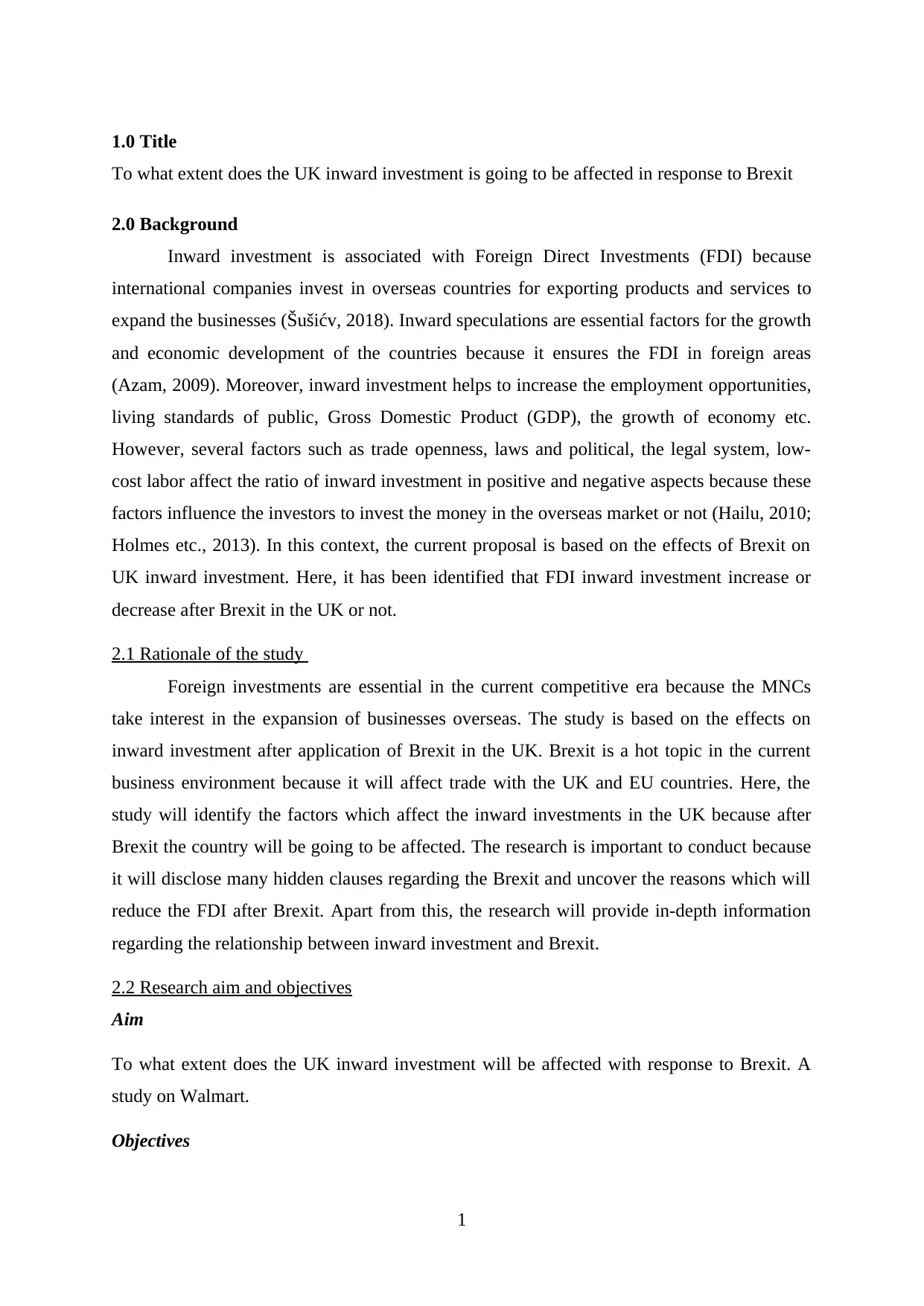
1.0 Title
To what extent does the UK inward investment is going to be affected in response to Brexit
2.0 Background
Inward investment is associated with Foreign Direct Investments (FDI) because
international companies invest in overseas countries for exporting products and services to
expand the businesses (Šušićv, 2018). Inward speculations are essential factors for the growth
and economic development of the countries because it ensures the FDI in foreign areas
(Azam, 2009). Moreover, inward investment helps to increase the employment opportunities,
living standards of public, Gross Domestic Product (GDP), the growth of economy etc.
However, several factors such as trade openness, laws and political, the legal system, low-
cost labor affect the ratio of inward investment in positive and negative aspects because these
factors influence the investors to invest the money in the overseas market or not (Hailu, 2010;
Holmes etc., 2013). In this context, the current proposal is based on the effects of Brexit on
UK inward investment. Here, it has been identified that FDI inward investment increase or
decrease after Brexit in the UK or not.
2.1 Rationale of the study
Foreign investments are essential in the current competitive era because the MNCs
take interest in the expansion of businesses overseas. The study is based on the effects on
inward investment after application of Brexit in the UK. Brexit is a hot topic in the current
business environment because it will affect trade with the UK and EU countries. Here, the
study will identify the factors which affect the inward investments in the UK because after
Brexit the country will be going to be affected. The research is important to conduct because
it will disclose many hidden clauses regarding the Brexit and uncover the reasons which will
reduce the FDI after Brexit. Apart from this, the research will provide in-depth information
regarding the relationship between inward investment and Brexit.
2.2 Research aim and objectives
Aim
To what extent does the UK inward investment will be affected with response to Brexit. A
study on Walmart.
Objectives
1
To what extent does the UK inward investment is going to be affected in response to Brexit
2.0 Background
Inward investment is associated with Foreign Direct Investments (FDI) because
international companies invest in overseas countries for exporting products and services to
expand the businesses (Šušićv, 2018). Inward speculations are essential factors for the growth
and economic development of the countries because it ensures the FDI in foreign areas
(Azam, 2009). Moreover, inward investment helps to increase the employment opportunities,
living standards of public, Gross Domestic Product (GDP), the growth of economy etc.
However, several factors such as trade openness, laws and political, the legal system, low-
cost labor affect the ratio of inward investment in positive and negative aspects because these
factors influence the investors to invest the money in the overseas market or not (Hailu, 2010;
Holmes etc., 2013). In this context, the current proposal is based on the effects of Brexit on
UK inward investment. Here, it has been identified that FDI inward investment increase or
decrease after Brexit in the UK or not.
2.1 Rationale of the study
Foreign investments are essential in the current competitive era because the MNCs
take interest in the expansion of businesses overseas. The study is based on the effects on
inward investment after application of Brexit in the UK. Brexit is a hot topic in the current
business environment because it will affect trade with the UK and EU countries. Here, the
study will identify the factors which affect the inward investments in the UK because after
Brexit the country will be going to be affected. The research is important to conduct because
it will disclose many hidden clauses regarding the Brexit and uncover the reasons which will
reduce the FDI after Brexit. Apart from this, the research will provide in-depth information
regarding the relationship between inward investment and Brexit.
2.2 Research aim and objectives
Aim
To what extent does the UK inward investment will be affected with response to Brexit. A
study on Walmart.
Objectives
1
Paraphrase This Document
Need a fresh take? Get an instant paraphrase of this document with our AI Paraphraser
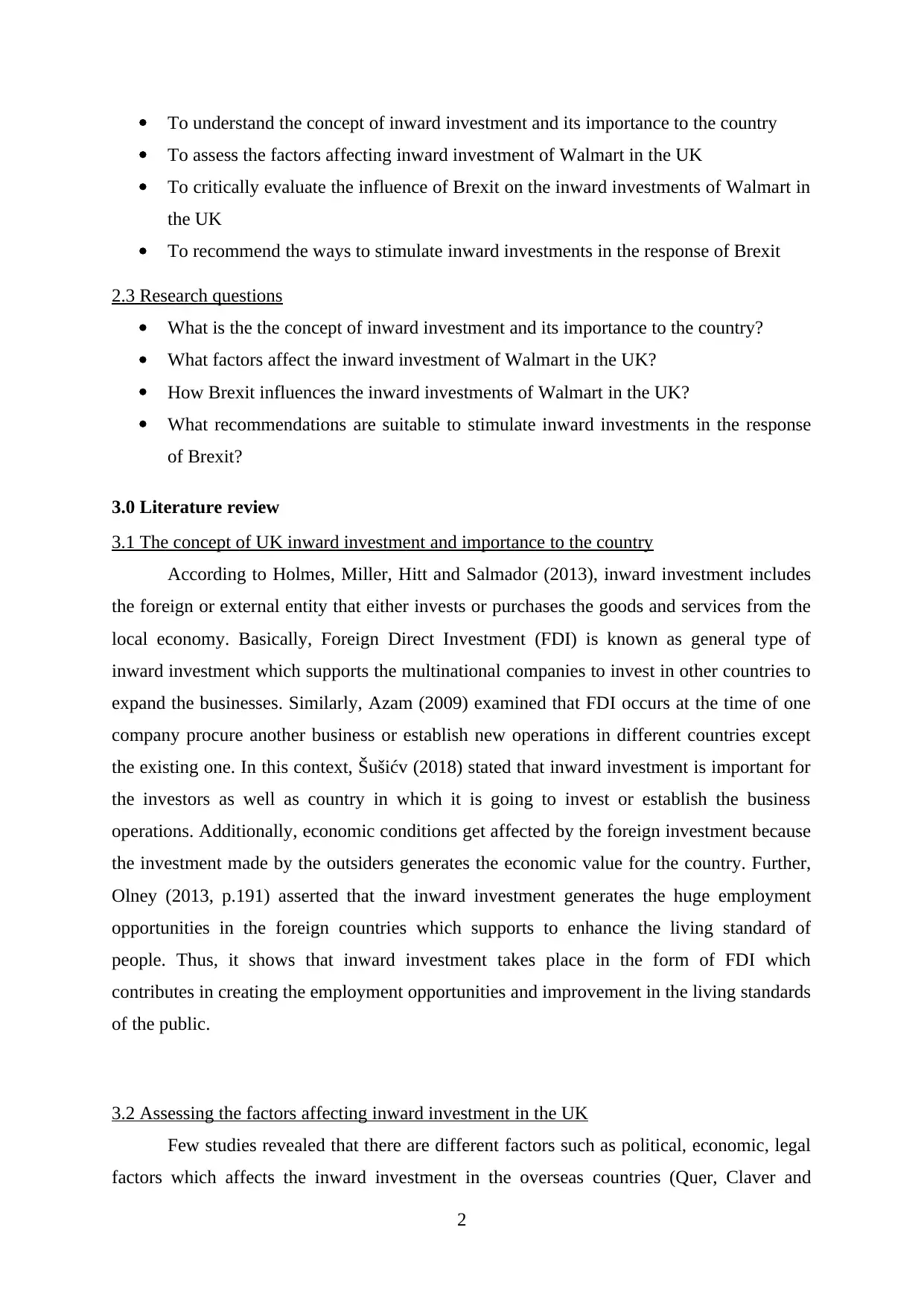
To understand the concept of inward investment and its importance to the country
To assess the factors affecting inward investment of Walmart in the UK
To critically evaluate the influence of Brexit on the inward investments of Walmart in
the UK
To recommend the ways to stimulate inward investments in the response of Brexit
2.3 Research questions
What is the the concept of inward investment and its importance to the country?
What factors affect the inward investment of Walmart in the UK?
How Brexit influences the inward investments of Walmart in the UK?
What recommendations are suitable to stimulate inward investments in the response
of Brexit?
3.0 Literature review
3.1 The concept of UK inward investment and importance to the country
According to Holmes, Miller, Hitt and Salmador (2013), inward investment includes
the foreign or external entity that either invests or purchases the goods and services from the
local economy. Basically, Foreign Direct Investment (FDI) is known as general type of
inward investment which supports the multinational companies to invest in other countries to
expand the businesses. Similarly, Azam (2009) examined that FDI occurs at the time of one
company procure another business or establish new operations in different countries except
the existing one. In this context, Šušićv (2018) stated that inward investment is important for
the investors as well as country in which it is going to invest or establish the business
operations. Additionally, economic conditions get affected by the foreign investment because
the investment made by the outsiders generates the economic value for the country. Further,
Olney (2013, p.191) asserted that the inward investment generates the huge employment
opportunities in the foreign countries which supports to enhance the living standard of
people. Thus, it shows that inward investment takes place in the form of FDI which
contributes in creating the employment opportunities and improvement in the living standards
of the public.
3.2 Assessing the factors affecting inward investment in the UK
Few studies revealed that there are different factors such as political, economic, legal
factors which affects the inward investment in the overseas countries (Quer, Claver and
2
To assess the factors affecting inward investment of Walmart in the UK
To critically evaluate the influence of Brexit on the inward investments of Walmart in
the UK
To recommend the ways to stimulate inward investments in the response of Brexit
2.3 Research questions
What is the the concept of inward investment and its importance to the country?
What factors affect the inward investment of Walmart in the UK?
How Brexit influences the inward investments of Walmart in the UK?
What recommendations are suitable to stimulate inward investments in the response
of Brexit?
3.0 Literature review
3.1 The concept of UK inward investment and importance to the country
According to Holmes, Miller, Hitt and Salmador (2013), inward investment includes
the foreign or external entity that either invests or purchases the goods and services from the
local economy. Basically, Foreign Direct Investment (FDI) is known as general type of
inward investment which supports the multinational companies to invest in other countries to
expand the businesses. Similarly, Azam (2009) examined that FDI occurs at the time of one
company procure another business or establish new operations in different countries except
the existing one. In this context, Šušićv (2018) stated that inward investment is important for
the investors as well as country in which it is going to invest or establish the business
operations. Additionally, economic conditions get affected by the foreign investment because
the investment made by the outsiders generates the economic value for the country. Further,
Olney (2013, p.191) asserted that the inward investment generates the huge employment
opportunities in the foreign countries which supports to enhance the living standard of
people. Thus, it shows that inward investment takes place in the form of FDI which
contributes in creating the employment opportunities and improvement in the living standards
of the public.
3.2 Assessing the factors affecting inward investment in the UK
Few studies revealed that there are different factors such as political, economic, legal
factors which affects the inward investment in the overseas countries (Quer, Claver and
2
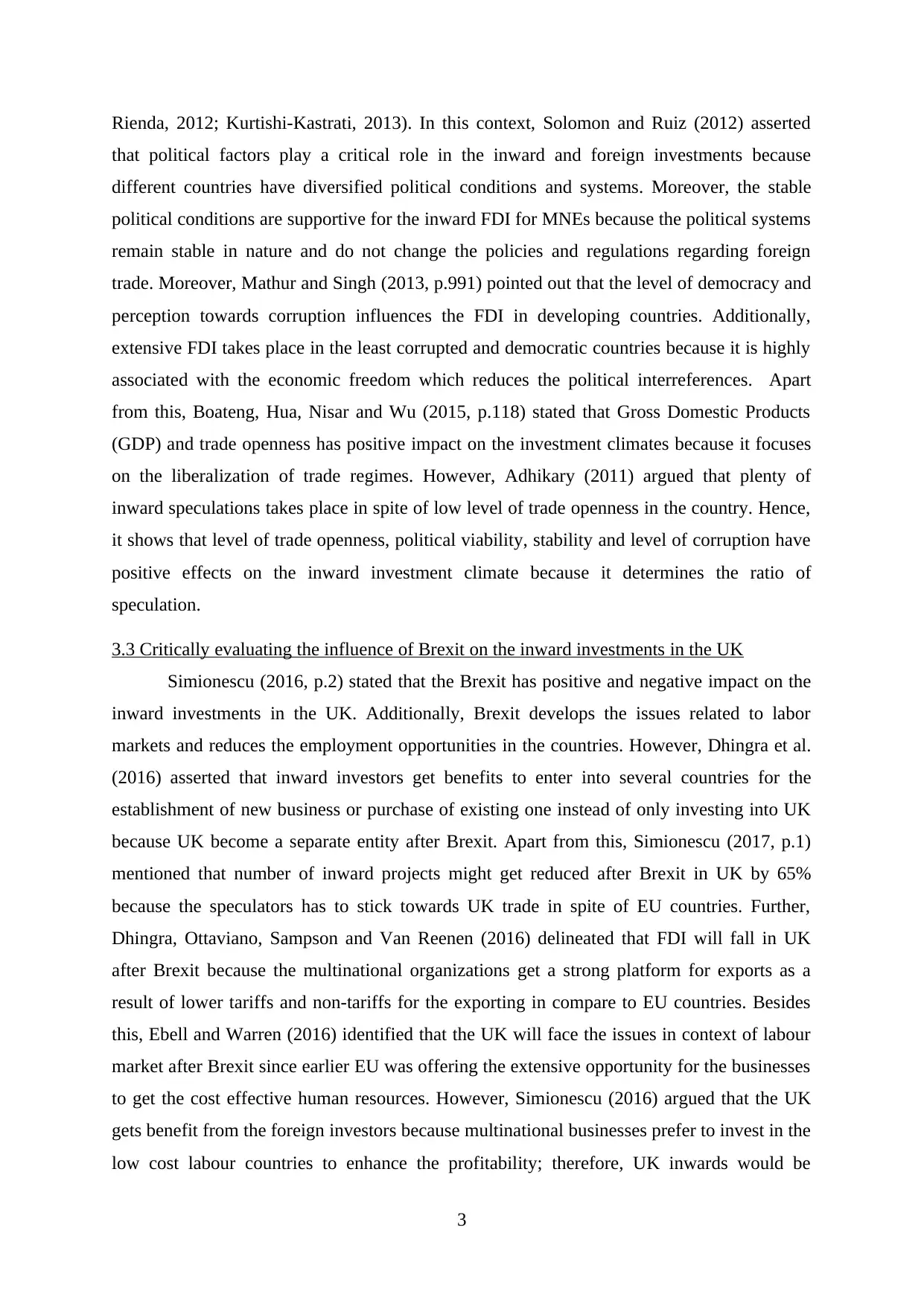
Rienda, 2012; Kurtishi-Kastrati, 2013). In this context, Solomon and Ruiz (2012) asserted
that political factors play a critical role in the inward and foreign investments because
different countries have diversified political conditions and systems. Moreover, the stable
political conditions are supportive for the inward FDI for MNEs because the political systems
remain stable in nature and do not change the policies and regulations regarding foreign
trade. Moreover, Mathur and Singh (2013, p.991) pointed out that the level of democracy and
perception towards corruption influences the FDI in developing countries. Additionally,
extensive FDI takes place in the least corrupted and democratic countries because it is highly
associated with the economic freedom which reduces the political interreferences. Apart
from this, Boateng, Hua, Nisar and Wu (2015, p.118) stated that Gross Domestic Products
(GDP) and trade openness has positive impact on the investment climates because it focuses
on the liberalization of trade regimes. However, Adhikary (2011) argued that plenty of
inward speculations takes place in spite of low level of trade openness in the country. Hence,
it shows that level of trade openness, political viability, stability and level of corruption have
positive effects on the inward investment climate because it determines the ratio of
speculation.
3.3 Critically evaluating the influence of Brexit on the inward investments in the UK
Simionescu (2016, p.2) stated that the Brexit has positive and negative impact on the
inward investments in the UK. Additionally, Brexit develops the issues related to labor
markets and reduces the employment opportunities in the countries. However, Dhingra et al.
(2016) asserted that inward investors get benefits to enter into several countries for the
establishment of new business or purchase of existing one instead of only investing into UK
because UK become a separate entity after Brexit. Apart from this, Simionescu (2017, p.1)
mentioned that number of inward projects might get reduced after Brexit in UK by 65%
because the speculators has to stick towards UK trade in spite of EU countries. Further,
Dhingra, Ottaviano, Sampson and Van Reenen (2016) delineated that FDI will fall in UK
after Brexit because the multinational organizations get a strong platform for exports as a
result of lower tariffs and non-tariffs for the exporting in compare to EU countries. Besides
this, Ebell and Warren (2016) identified that the UK will face the issues in context of labour
market after Brexit since earlier EU was offering the extensive opportunity for the businesses
to get the cost effective human resources. However, Simionescu (2016) argued that the UK
gets benefit from the foreign investors because multinational businesses prefer to invest in the
low cost labour countries to enhance the profitability; therefore, UK inwards would be
3
that political factors play a critical role in the inward and foreign investments because
different countries have diversified political conditions and systems. Moreover, the stable
political conditions are supportive for the inward FDI for MNEs because the political systems
remain stable in nature and do not change the policies and regulations regarding foreign
trade. Moreover, Mathur and Singh (2013, p.991) pointed out that the level of democracy and
perception towards corruption influences the FDI in developing countries. Additionally,
extensive FDI takes place in the least corrupted and democratic countries because it is highly
associated with the economic freedom which reduces the political interreferences. Apart
from this, Boateng, Hua, Nisar and Wu (2015, p.118) stated that Gross Domestic Products
(GDP) and trade openness has positive impact on the investment climates because it focuses
on the liberalization of trade regimes. However, Adhikary (2011) argued that plenty of
inward speculations takes place in spite of low level of trade openness in the country. Hence,
it shows that level of trade openness, political viability, stability and level of corruption have
positive effects on the inward investment climate because it determines the ratio of
speculation.
3.3 Critically evaluating the influence of Brexit on the inward investments in the UK
Simionescu (2016, p.2) stated that the Brexit has positive and negative impact on the
inward investments in the UK. Additionally, Brexit develops the issues related to labor
markets and reduces the employment opportunities in the countries. However, Dhingra et al.
(2016) asserted that inward investors get benefits to enter into several countries for the
establishment of new business or purchase of existing one instead of only investing into UK
because UK become a separate entity after Brexit. Apart from this, Simionescu (2017, p.1)
mentioned that number of inward projects might get reduced after Brexit in UK by 65%
because the speculators has to stick towards UK trade in spite of EU countries. Further,
Dhingra, Ottaviano, Sampson and Van Reenen (2016) delineated that FDI will fall in UK
after Brexit because the multinational organizations get a strong platform for exports as a
result of lower tariffs and non-tariffs for the exporting in compare to EU countries. Besides
this, Ebell and Warren (2016) identified that the UK will face the issues in context of labour
market after Brexit since earlier EU was offering the extensive opportunity for the businesses
to get the cost effective human resources. However, Simionescu (2016) argued that the UK
gets benefit from the foreign investors because multinational businesses prefer to invest in the
low cost labour countries to enhance the profitability; therefore, UK inwards would be
3
⊘ This is a preview!⊘
Do you want full access?
Subscribe today to unlock all pages.

Trusted by 1+ million students worldwide
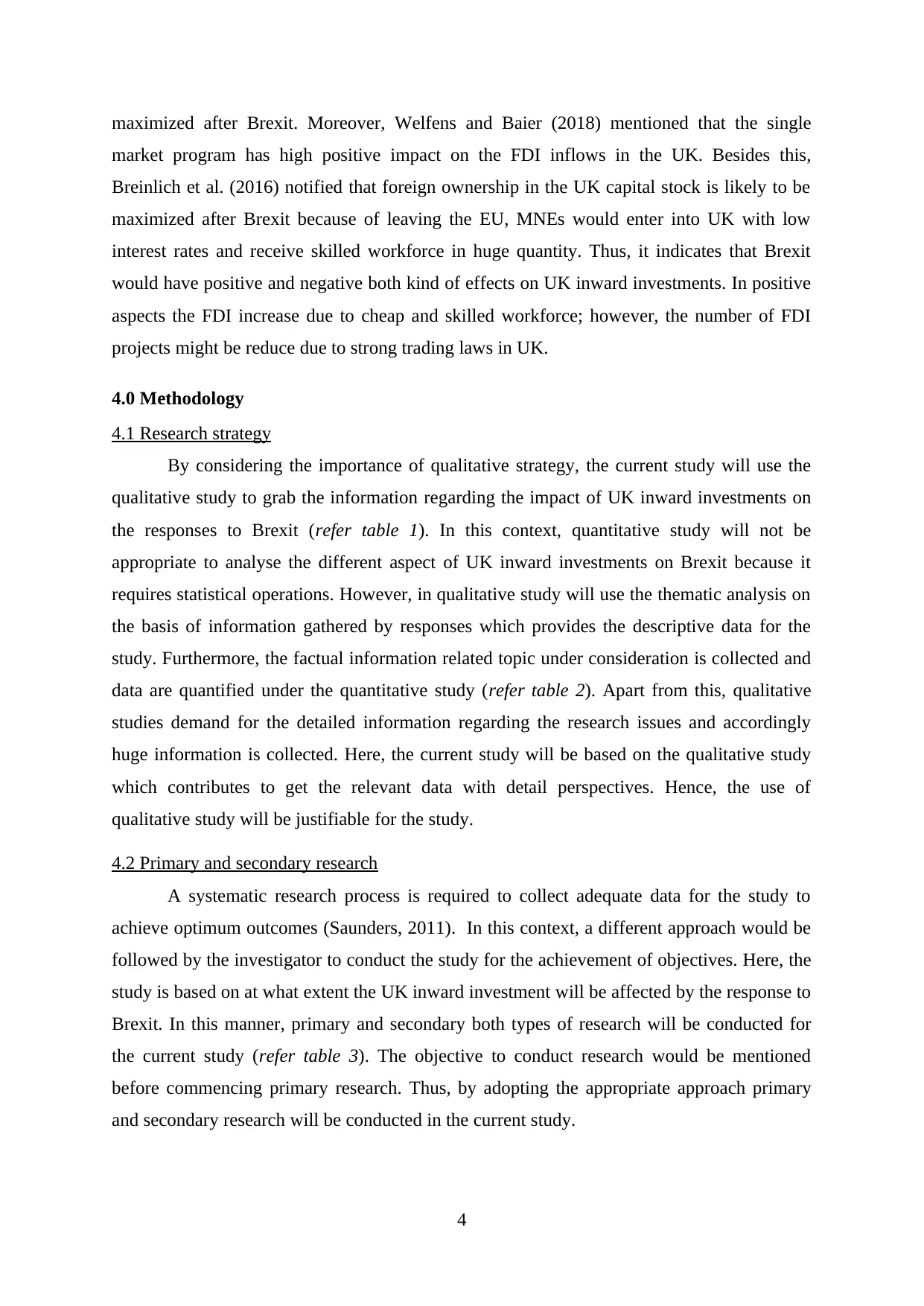
maximized after Brexit. Moreover, Welfens and Baier (2018) mentioned that the single
market program has high positive impact on the FDI inflows in the UK. Besides this,
Breinlich et al. (2016) notified that foreign ownership in the UK capital stock is likely to be
maximized after Brexit because of leaving the EU, MNEs would enter into UK with low
interest rates and receive skilled workforce in huge quantity. Thus, it indicates that Brexit
would have positive and negative both kind of effects on UK inward investments. In positive
aspects the FDI increase due to cheap and skilled workforce; however, the number of FDI
projects might be reduce due to strong trading laws in UK.
4.0 Methodology
4.1 Research strategy
By considering the importance of qualitative strategy, the current study will use the
qualitative study to grab the information regarding the impact of UK inward investments on
the responses to Brexit (refer table 1). In this context, quantitative study will not be
appropriate to analyse the different aspect of UK inward investments on Brexit because it
requires statistical operations. However, in qualitative study will use the thematic analysis on
the basis of information gathered by responses which provides the descriptive data for the
study. Furthermore, the factual information related topic under consideration is collected and
data are quantified under the quantitative study (refer table 2). Apart from this, qualitative
studies demand for the detailed information regarding the research issues and accordingly
huge information is collected. Here, the current study will be based on the qualitative study
which contributes to get the relevant data with detail perspectives. Hence, the use of
qualitative study will be justifiable for the study.
4.2 Primary and secondary research
A systematic research process is required to collect adequate data for the study to
achieve optimum outcomes (Saunders, 2011). In this context, a different approach would be
followed by the investigator to conduct the study for the achievement of objectives. Here, the
study is based on at what extent the UK inward investment will be affected by the response to
Brexit. In this manner, primary and secondary both types of research will be conducted for
the current study (refer table 3). The objective to conduct research would be mentioned
before commencing primary research. Thus, by adopting the appropriate approach primary
and secondary research will be conducted in the current study.
4
market program has high positive impact on the FDI inflows in the UK. Besides this,
Breinlich et al. (2016) notified that foreign ownership in the UK capital stock is likely to be
maximized after Brexit because of leaving the EU, MNEs would enter into UK with low
interest rates and receive skilled workforce in huge quantity. Thus, it indicates that Brexit
would have positive and negative both kind of effects on UK inward investments. In positive
aspects the FDI increase due to cheap and skilled workforce; however, the number of FDI
projects might be reduce due to strong trading laws in UK.
4.0 Methodology
4.1 Research strategy
By considering the importance of qualitative strategy, the current study will use the
qualitative study to grab the information regarding the impact of UK inward investments on
the responses to Brexit (refer table 1). In this context, quantitative study will not be
appropriate to analyse the different aspect of UK inward investments on Brexit because it
requires statistical operations. However, in qualitative study will use the thematic analysis on
the basis of information gathered by responses which provides the descriptive data for the
study. Furthermore, the factual information related topic under consideration is collected and
data are quantified under the quantitative study (refer table 2). Apart from this, qualitative
studies demand for the detailed information regarding the research issues and accordingly
huge information is collected. Here, the current study will be based on the qualitative study
which contributes to get the relevant data with detail perspectives. Hence, the use of
qualitative study will be justifiable for the study.
4.2 Primary and secondary research
A systematic research process is required to collect adequate data for the study to
achieve optimum outcomes (Saunders, 2011). In this context, a different approach would be
followed by the investigator to conduct the study for the achievement of objectives. Here, the
study is based on at what extent the UK inward investment will be affected by the response to
Brexit. In this manner, primary and secondary both types of research will be conducted for
the current study (refer table 3). The objective to conduct research would be mentioned
before commencing primary research. Thus, by adopting the appropriate approach primary
and secondary research will be conducted in the current study.
4
Paraphrase This Document
Need a fresh take? Get an instant paraphrase of this document with our AI Paraphraser
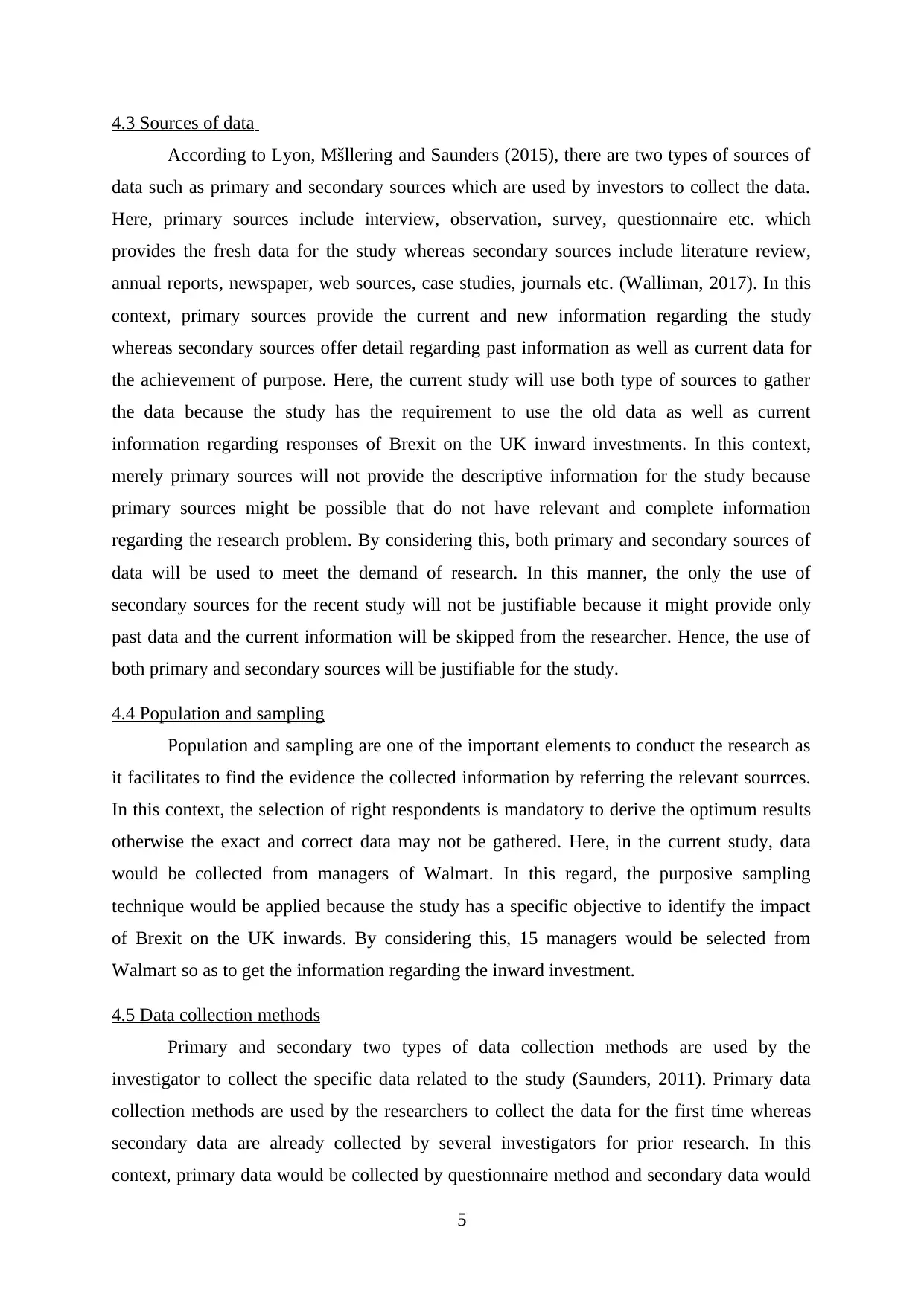
4.3 Sources of data
According to Lyon, Mšllering and Saunders (2015), there are two types of sources of
data such as primary and secondary sources which are used by investors to collect the data.
Here, primary sources include interview, observation, survey, questionnaire etc. which
provides the fresh data for the study whereas secondary sources include literature review,
annual reports, newspaper, web sources, case studies, journals etc. (Walliman, 2017). In this
context, primary sources provide the current and new information regarding the study
whereas secondary sources offer detail regarding past information as well as current data for
the achievement of purpose. Here, the current study will use both type of sources to gather
the data because the study has the requirement to use the old data as well as current
information regarding responses of Brexit on the UK inward investments. In this context,
merely primary sources will not provide the descriptive information for the study because
primary sources might be possible that do not have relevant and complete information
regarding the research problem. By considering this, both primary and secondary sources of
data will be used to meet the demand of research. In this manner, the only the use of
secondary sources for the recent study will not be justifiable because it might provide only
past data and the current information will be skipped from the researcher. Hence, the use of
both primary and secondary sources will be justifiable for the study.
4.4 Population and sampling
Population and sampling are one of the important elements to conduct the research as
it facilitates to find the evidence the collected information by referring the relevant sourrces.
In this context, the selection of right respondents is mandatory to derive the optimum results
otherwise the exact and correct data may not be gathered. Here, in the current study, data
would be collected from managers of Walmart. In this regard, the purposive sampling
technique would be applied because the study has a specific objective to identify the impact
of Brexit on the UK inwards. By considering this, 15 managers would be selected from
Walmart so as to get the information regarding the inward investment.
4.5 Data collection methods
Primary and secondary two types of data collection methods are used by the
investigator to collect the specific data related to the study (Saunders, 2011). Primary data
collection methods are used by the researchers to collect the data for the first time whereas
secondary data are already collected by several investigators for prior research. In this
context, primary data would be collected by questionnaire method and secondary data would
5
According to Lyon, Mšllering and Saunders (2015), there are two types of sources of
data such as primary and secondary sources which are used by investors to collect the data.
Here, primary sources include interview, observation, survey, questionnaire etc. which
provides the fresh data for the study whereas secondary sources include literature review,
annual reports, newspaper, web sources, case studies, journals etc. (Walliman, 2017). In this
context, primary sources provide the current and new information regarding the study
whereas secondary sources offer detail regarding past information as well as current data for
the achievement of purpose. Here, the current study will use both type of sources to gather
the data because the study has the requirement to use the old data as well as current
information regarding responses of Brexit on the UK inward investments. In this context,
merely primary sources will not provide the descriptive information for the study because
primary sources might be possible that do not have relevant and complete information
regarding the research problem. By considering this, both primary and secondary sources of
data will be used to meet the demand of research. In this manner, the only the use of
secondary sources for the recent study will not be justifiable because it might provide only
past data and the current information will be skipped from the researcher. Hence, the use of
both primary and secondary sources will be justifiable for the study.
4.4 Population and sampling
Population and sampling are one of the important elements to conduct the research as
it facilitates to find the evidence the collected information by referring the relevant sourrces.
In this context, the selection of right respondents is mandatory to derive the optimum results
otherwise the exact and correct data may not be gathered. Here, in the current study, data
would be collected from managers of Walmart. In this regard, the purposive sampling
technique would be applied because the study has a specific objective to identify the impact
of Brexit on the UK inwards. By considering this, 15 managers would be selected from
Walmart so as to get the information regarding the inward investment.
4.5 Data collection methods
Primary and secondary two types of data collection methods are used by the
investigator to collect the specific data related to the study (Saunders, 2011). Primary data
collection methods are used by the researchers to collect the data for the first time whereas
secondary data are already collected by several investigators for prior research. In this
context, primary data would be collected by questionnaire method and secondary data would
5
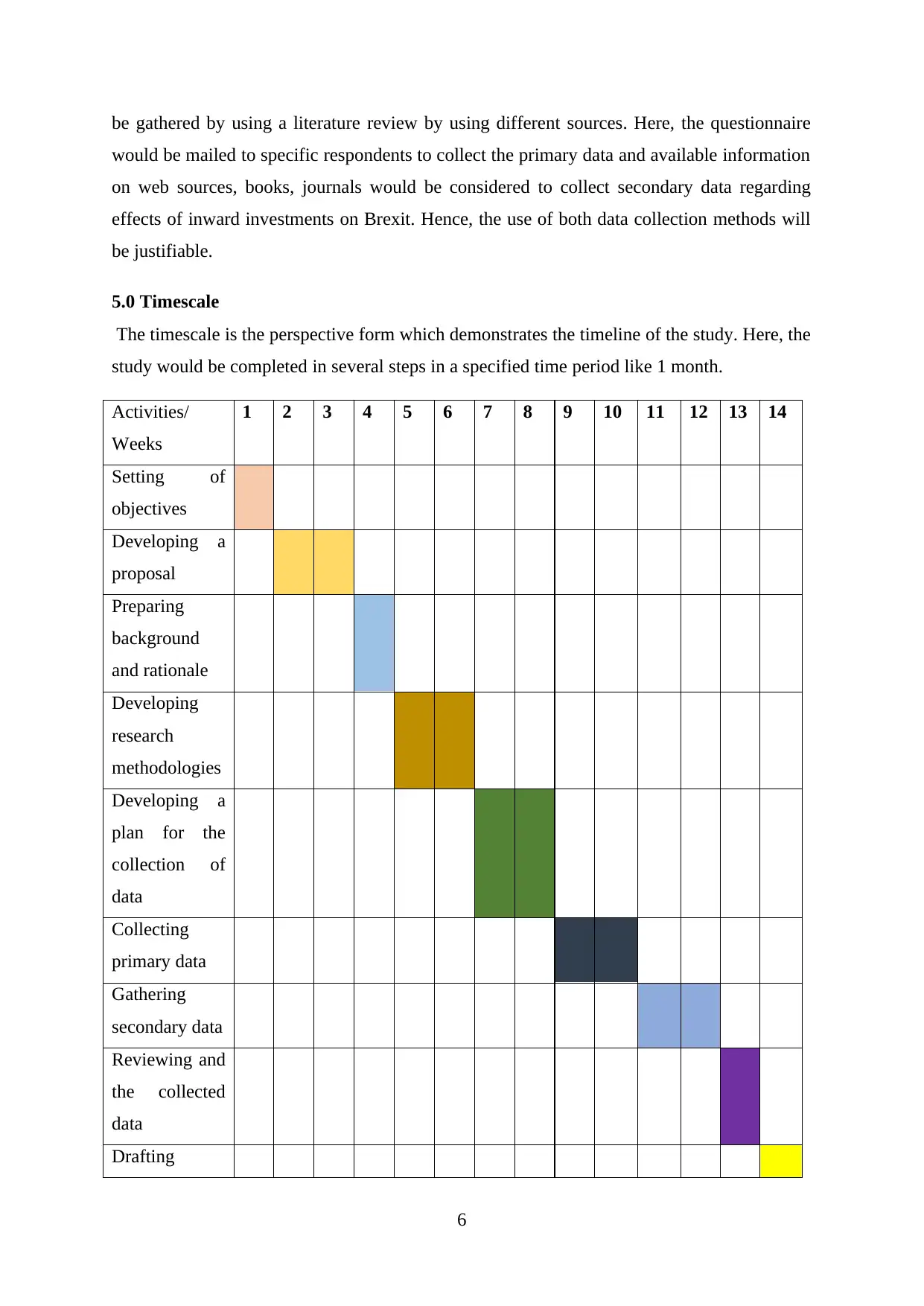
be gathered by using a literature review by using different sources. Here, the questionnaire
would be mailed to specific respondents to collect the primary data and available information
on web sources, books, journals would be considered to collect secondary data regarding
effects of inward investments on Brexit. Hence, the use of both data collection methods will
be justifiable.
5.0 Timescale
The timescale is the perspective form which demonstrates the timeline of the study. Here, the
study would be completed in several steps in a specified time period like 1 month.
Activities/
Weeks
1 2 3 4 5 6 7 8 9 10 11 12 13 14
Setting of
objectives
Developing a
proposal
Preparing
background
and rationale
Developing
research
methodologies
Developing a
plan for the
collection of
data
Collecting
primary data
Gathering
secondary data
Reviewing and
the collected
data
Drafting
6
would be mailed to specific respondents to collect the primary data and available information
on web sources, books, journals would be considered to collect secondary data regarding
effects of inward investments on Brexit. Hence, the use of both data collection methods will
be justifiable.
5.0 Timescale
The timescale is the perspective form which demonstrates the timeline of the study. Here, the
study would be completed in several steps in a specified time period like 1 month.
Activities/
Weeks
1 2 3 4 5 6 7 8 9 10 11 12 13 14
Setting of
objectives
Developing a
proposal
Preparing
background
and rationale
Developing
research
methodologies
Developing a
plan for the
collection of
data
Collecting
primary data
Gathering
secondary data
Reviewing and
the collected
data
Drafting
6
⊘ This is a preview!⊘
Do you want full access?
Subscribe today to unlock all pages.

Trusted by 1+ million students worldwide
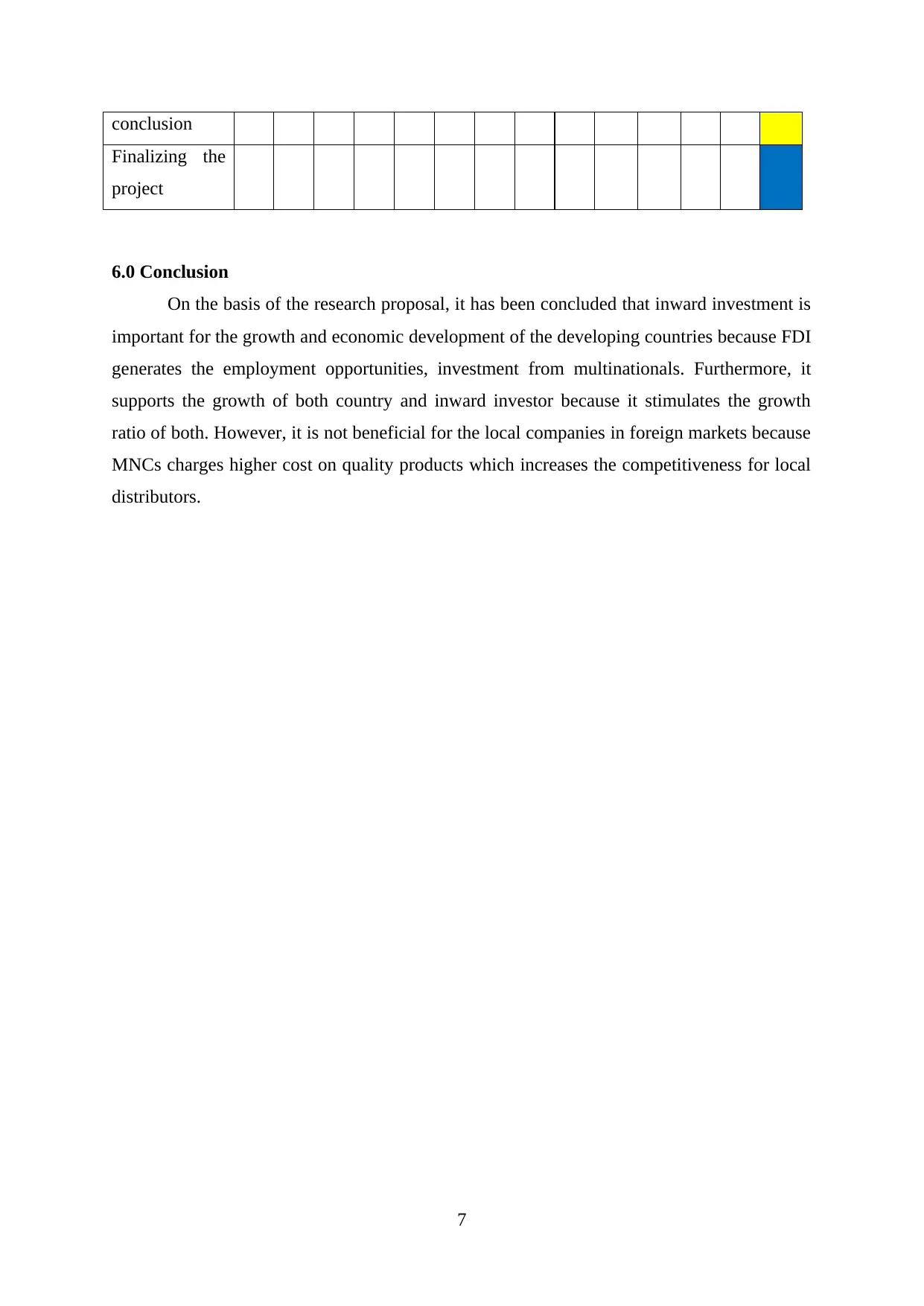
conclusion
Finalizing the
project
6.0 Conclusion
On the basis of the research proposal, it has been concluded that inward investment is
important for the growth and economic development of the developing countries because FDI
generates the employment opportunities, investment from multinationals. Furthermore, it
supports the growth of both country and inward investor because it stimulates the growth
ratio of both. However, it is not beneficial for the local companies in foreign markets because
MNCs charges higher cost on quality products which increases the competitiveness for local
distributors.
7
Finalizing the
project
6.0 Conclusion
On the basis of the research proposal, it has been concluded that inward investment is
important for the growth and economic development of the developing countries because FDI
generates the employment opportunities, investment from multinationals. Furthermore, it
supports the growth of both country and inward investor because it stimulates the growth
ratio of both. However, it is not beneficial for the local companies in foreign markets because
MNCs charges higher cost on quality products which increases the competitiveness for local
distributors.
7
Paraphrase This Document
Need a fresh take? Get an instant paraphrase of this document with our AI Paraphraser
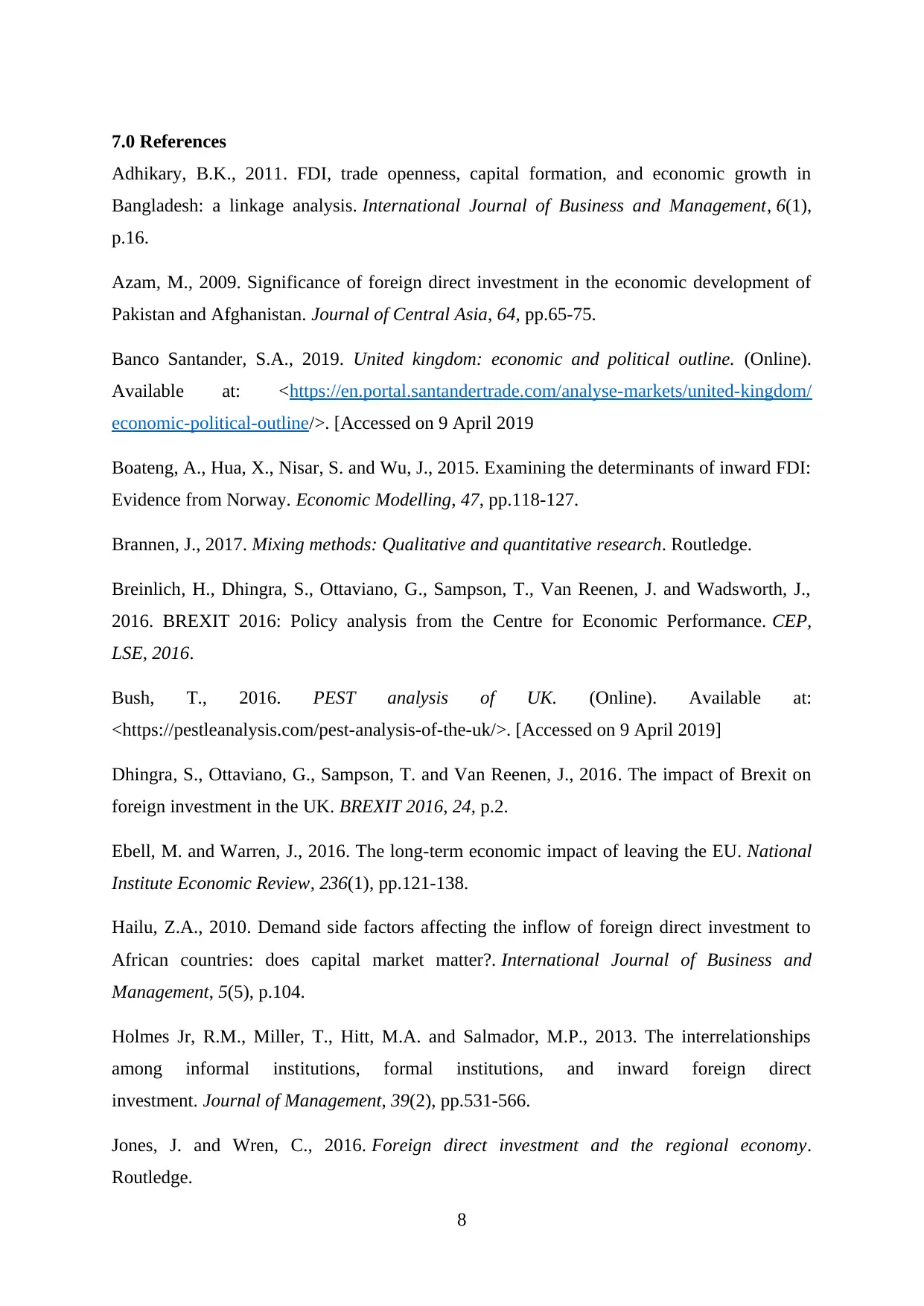
7.0 References
Adhikary, B.K., 2011. FDI, trade openness, capital formation, and economic growth in
Bangladesh: a linkage analysis. International Journal of Business and Management, 6(1),
p.16.
Azam, M., 2009. Significance of foreign direct investment in the economic development of
Pakistan and Afghanistan. Journal of Central Asia, 64, pp.65-75.
Banco Santander, S.A., 2019. United kingdom: economic and political outline. (Online).
Available at: <https://en.portal.santandertrade.com/analyse-markets/united-kingdom/
economic-political-outline/>. [Accessed on 9 April 2019
Boateng, A., Hua, X., Nisar, S. and Wu, J., 2015. Examining the determinants of inward FDI:
Evidence from Norway. Economic Modelling, 47, pp.118-127.
Brannen, J., 2017. Mixing methods: Qualitative and quantitative research. Routledge.
Breinlich, H., Dhingra, S., Ottaviano, G., Sampson, T., Van Reenen, J. and Wadsworth, J.,
2016. BREXIT 2016: Policy analysis from the Centre for Economic Performance. CEP,
LSE, 2016.
Bush, T., 2016. PEST analysis of UK. (Online). Available at:
<https://pestleanalysis.com/pest-analysis-of-the-uk/>. [Accessed on 9 April 2019]
Dhingra, S., Ottaviano, G., Sampson, T. and Van Reenen, J., 2016. The impact of Brexit on
foreign investment in the UK. BREXIT 2016, 24, p.2.
Ebell, M. and Warren, J., 2016. The long-term economic impact of leaving the EU. National
Institute Economic Review, 236(1), pp.121-138.
Hailu, Z.A., 2010. Demand side factors affecting the inflow of foreign direct investment to
African countries: does capital market matter?. International Journal of Business and
Management, 5(5), p.104.
Holmes Jr, R.M., Miller, T., Hitt, M.A. and Salmador, M.P., 2013. The interrelationships
among informal institutions, formal institutions, and inward foreign direct
investment. Journal of Management, 39(2), pp.531-566.
Jones, J. and Wren, C., 2016. Foreign direct investment and the regional economy.
Routledge.
8
Adhikary, B.K., 2011. FDI, trade openness, capital formation, and economic growth in
Bangladesh: a linkage analysis. International Journal of Business and Management, 6(1),
p.16.
Azam, M., 2009. Significance of foreign direct investment in the economic development of
Pakistan and Afghanistan. Journal of Central Asia, 64, pp.65-75.
Banco Santander, S.A., 2019. United kingdom: economic and political outline. (Online).
Available at: <https://en.portal.santandertrade.com/analyse-markets/united-kingdom/
economic-political-outline/>. [Accessed on 9 April 2019
Boateng, A., Hua, X., Nisar, S. and Wu, J., 2015. Examining the determinants of inward FDI:
Evidence from Norway. Economic Modelling, 47, pp.118-127.
Brannen, J., 2017. Mixing methods: Qualitative and quantitative research. Routledge.
Breinlich, H., Dhingra, S., Ottaviano, G., Sampson, T., Van Reenen, J. and Wadsworth, J.,
2016. BREXIT 2016: Policy analysis from the Centre for Economic Performance. CEP,
LSE, 2016.
Bush, T., 2016. PEST analysis of UK. (Online). Available at:
<https://pestleanalysis.com/pest-analysis-of-the-uk/>. [Accessed on 9 April 2019]
Dhingra, S., Ottaviano, G., Sampson, T. and Van Reenen, J., 2016. The impact of Brexit on
foreign investment in the UK. BREXIT 2016, 24, p.2.
Ebell, M. and Warren, J., 2016. The long-term economic impact of leaving the EU. National
Institute Economic Review, 236(1), pp.121-138.
Hailu, Z.A., 2010. Demand side factors affecting the inflow of foreign direct investment to
African countries: does capital market matter?. International Journal of Business and
Management, 5(5), p.104.
Holmes Jr, R.M., Miller, T., Hitt, M.A. and Salmador, M.P., 2013. The interrelationships
among informal institutions, formal institutions, and inward foreign direct
investment. Journal of Management, 39(2), pp.531-566.
Jones, J. and Wren, C., 2016. Foreign direct investment and the regional economy.
Routledge.
8
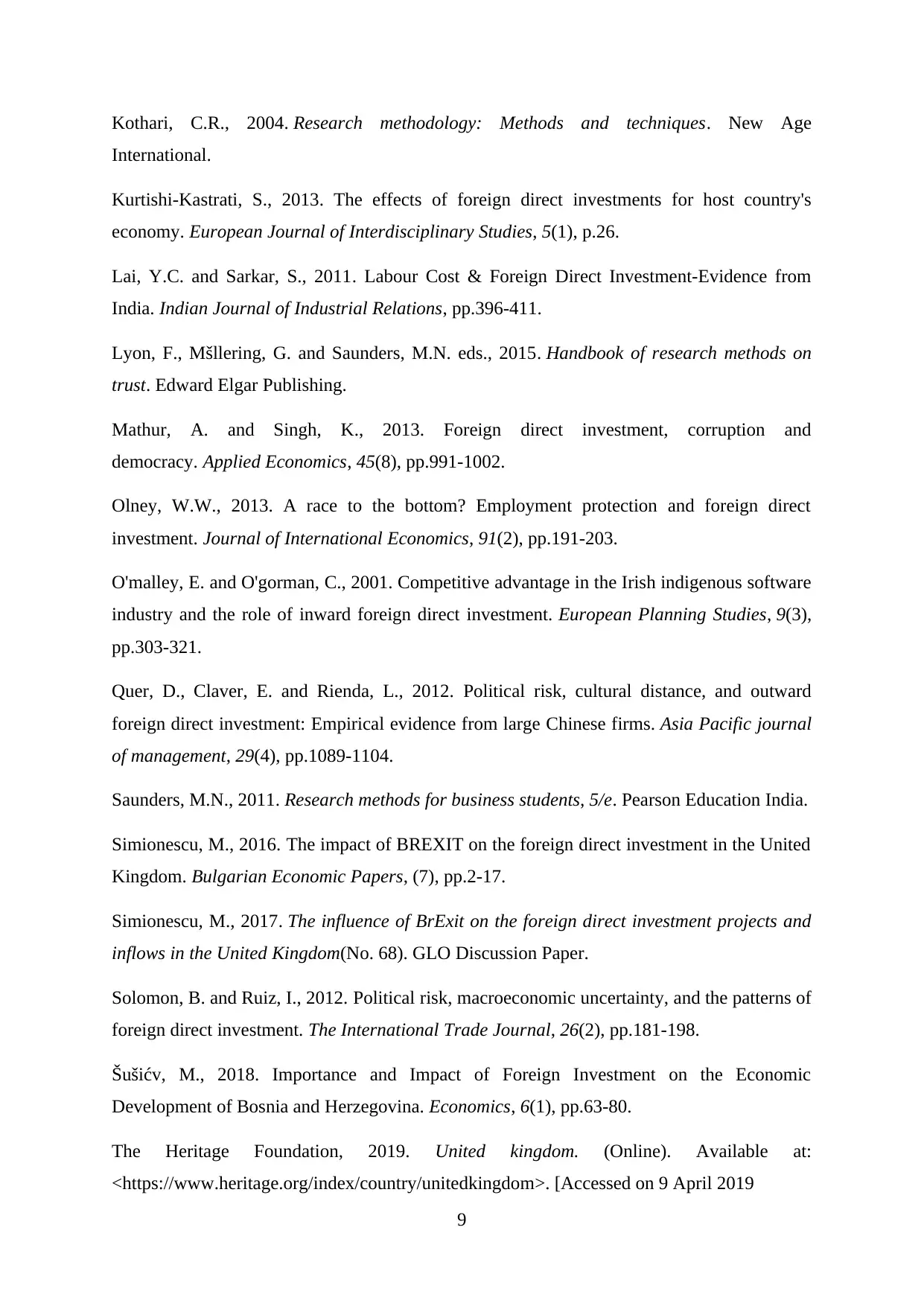
Kothari, C.R., 2004. Research methodology: Methods and techniques. New Age
International.
Kurtishi-Kastrati, S., 2013. The effects of foreign direct investments for host country's
economy. European Journal of Interdisciplinary Studies, 5(1), p.26.
Lai, Y.C. and Sarkar, S., 2011. Labour Cost & Foreign Direct Investment-Evidence from
India. Indian Journal of Industrial Relations, pp.396-411.
Lyon, F., Mšllering, G. and Saunders, M.N. eds., 2015. Handbook of research methods on
trust. Edward Elgar Publishing.
Mathur, A. and Singh, K., 2013. Foreign direct investment, corruption and
democracy. Applied Economics, 45(8), pp.991-1002.
Olney, W.W., 2013. A race to the bottom? Employment protection and foreign direct
investment. Journal of International Economics, 91(2), pp.191-203.
O'malley, E. and O'gorman, C., 2001. Competitive advantage in the Irish indigenous software
industry and the role of inward foreign direct investment. European Planning Studies, 9(3),
pp.303-321.
Quer, D., Claver, E. and Rienda, L., 2012. Political risk, cultural distance, and outward
foreign direct investment: Empirical evidence from large Chinese firms. Asia Pacific journal
of management, 29(4), pp.1089-1104.
Saunders, M.N., 2011. Research methods for business students, 5/e. Pearson Education India.
Simionescu, M., 2016. The impact of BREXIT on the foreign direct investment in the United
Kingdom. Bulgarian Economic Papers, (7), pp.2-17.
Simionescu, M., 2017. The influence of BrExit on the foreign direct investment projects and
inflows in the United Kingdom(No. 68). GLO Discussion Paper.
Solomon, B. and Ruiz, I., 2012. Political risk, macroeconomic uncertainty, and the patterns of
foreign direct investment. The International Trade Journal, 26(2), pp.181-198.
Šušićv, M., 2018. Importance and Impact of Foreign Investment on the Economic
Development of Bosnia and Herzegovina. Economics, 6(1), pp.63-80.
The Heritage Foundation, 2019. United kingdom. (Online). Available at:
<https://www.heritage.org/index/country/unitedkingdom>. [Accessed on 9 April 2019
9
International.
Kurtishi-Kastrati, S., 2013. The effects of foreign direct investments for host country's
economy. European Journal of Interdisciplinary Studies, 5(1), p.26.
Lai, Y.C. and Sarkar, S., 2011. Labour Cost & Foreign Direct Investment-Evidence from
India. Indian Journal of Industrial Relations, pp.396-411.
Lyon, F., Mšllering, G. and Saunders, M.N. eds., 2015. Handbook of research methods on
trust. Edward Elgar Publishing.
Mathur, A. and Singh, K., 2013. Foreign direct investment, corruption and
democracy. Applied Economics, 45(8), pp.991-1002.
Olney, W.W., 2013. A race to the bottom? Employment protection and foreign direct
investment. Journal of International Economics, 91(2), pp.191-203.
O'malley, E. and O'gorman, C., 2001. Competitive advantage in the Irish indigenous software
industry and the role of inward foreign direct investment. European Planning Studies, 9(3),
pp.303-321.
Quer, D., Claver, E. and Rienda, L., 2012. Political risk, cultural distance, and outward
foreign direct investment: Empirical evidence from large Chinese firms. Asia Pacific journal
of management, 29(4), pp.1089-1104.
Saunders, M.N., 2011. Research methods for business students, 5/e. Pearson Education India.
Simionescu, M., 2016. The impact of BREXIT on the foreign direct investment in the United
Kingdom. Bulgarian Economic Papers, (7), pp.2-17.
Simionescu, M., 2017. The influence of BrExit on the foreign direct investment projects and
inflows in the United Kingdom(No. 68). GLO Discussion Paper.
Solomon, B. and Ruiz, I., 2012. Political risk, macroeconomic uncertainty, and the patterns of
foreign direct investment. The International Trade Journal, 26(2), pp.181-198.
Šušićv, M., 2018. Importance and Impact of Foreign Investment on the Economic
Development of Bosnia and Herzegovina. Economics, 6(1), pp.63-80.
The Heritage Foundation, 2019. United kingdom. (Online). Available at:
<https://www.heritage.org/index/country/unitedkingdom>. [Accessed on 9 April 2019
9
⊘ This is a preview!⊘
Do you want full access?
Subscribe today to unlock all pages.

Trusted by 1+ million students worldwide
1 out of 18
Related Documents
Your All-in-One AI-Powered Toolkit for Academic Success.
+13062052269
info@desklib.com
Available 24*7 on WhatsApp / Email
![[object Object]](/_next/static/media/star-bottom.7253800d.svg)
Unlock your academic potential
Copyright © 2020–2025 A2Z Services. All Rights Reserved. Developed and managed by ZUCOL.




